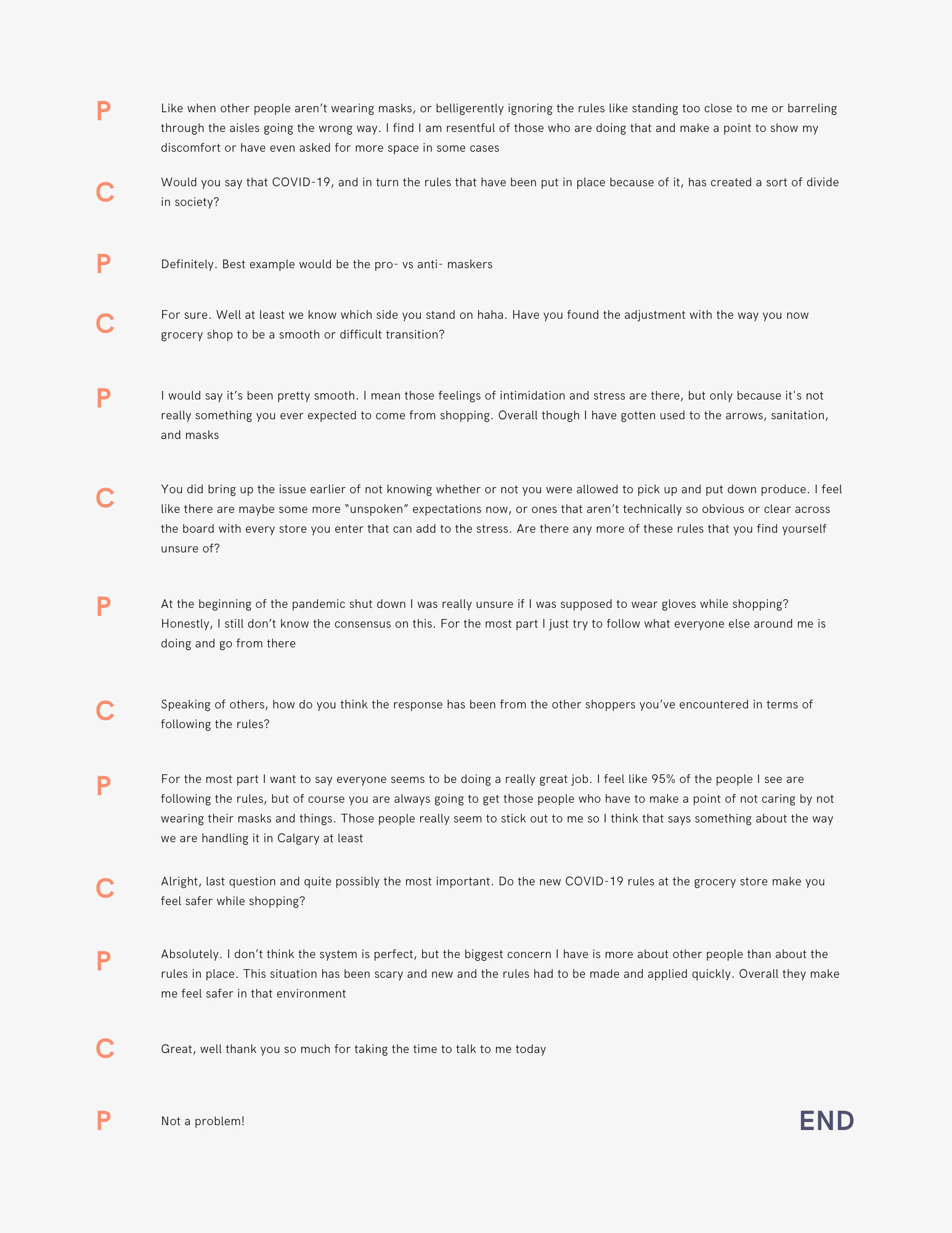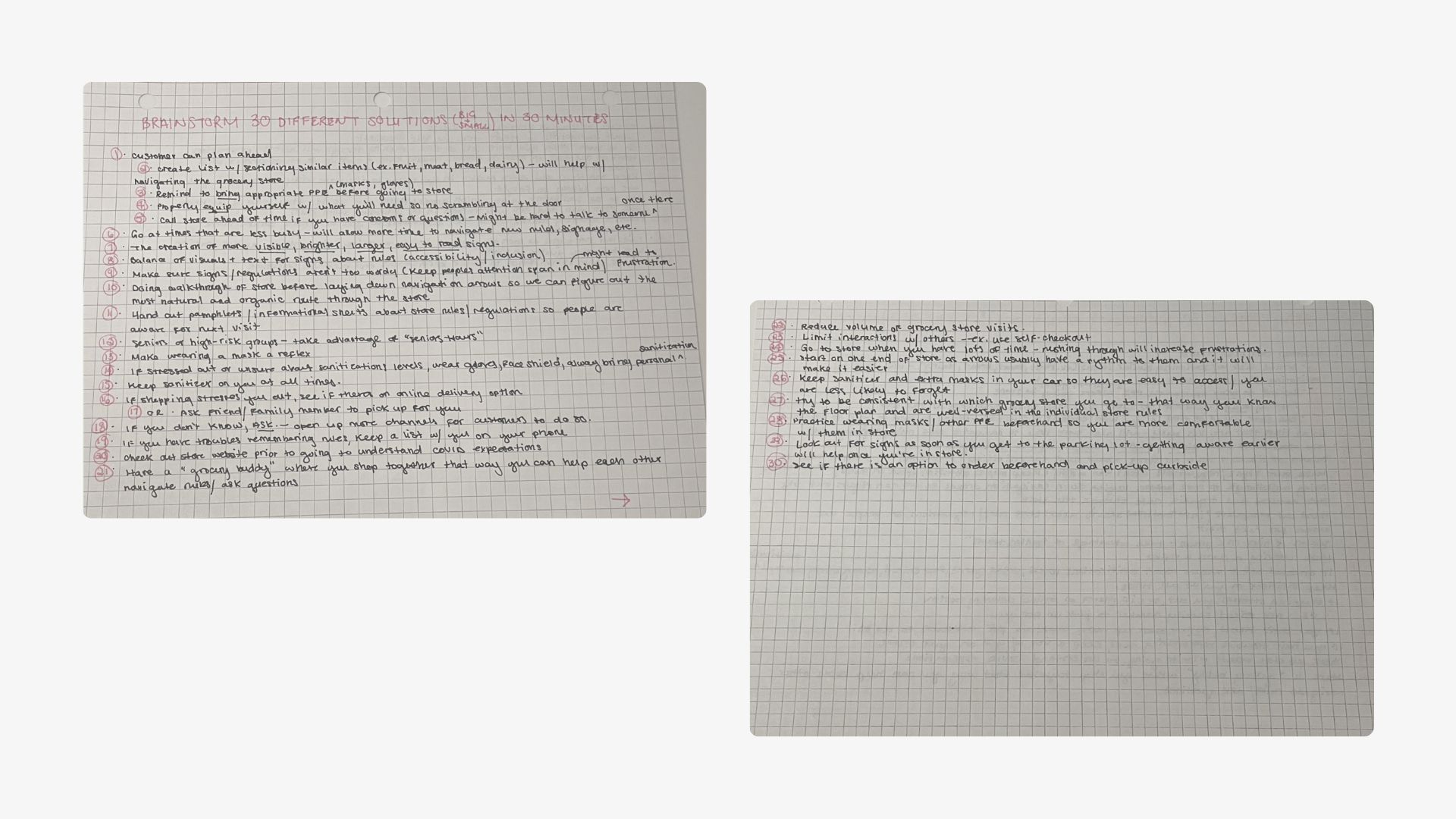Easing stress associated with grocery shopping during COVID-19 by designing a digital solution focused on accessible information regarding rules and regulations.
Project Course work for Principles of Design Thinking at Mount Royal University
Skills Research, Synthesis, Ideation, Concept Development, Prototyping, User Testing
Tools Adobe XD, Adobe Illustrator, Adobe Illustrator Draw, Google Forms
Date 2020
Video Walkthrough of Happy Grocery App
QR Code to Test App Solution
BACKGROUND
At the start of the COVID-19 pandemic, simple tasks such as grocery shopping were suddenly transformed into stressful experiences due to imposing etiquette expectations and unfamiliar social rules. Mask and separation regulations, limited store capacities/household-only shopping, and less defined rules such as not touching fruits and veggies were implemented overnight. Through application of a design process, I tackled the challenge and created an informed and innovative digital solution.
DESIGN CHALLENGE:
How can we make grocery shopping during COVID-19 less stressful with all the new rules to follow?
-- DESIGN PROCESS
________________________________________
EMPATHIZE // Research
This project began with research into the state of grocery shopping at the onset of the COVID-19 pandemic. Several ethnographic research methods were applied.
Grocery shopping during COVID-19 is:
"Intimidating. Stressful. Scary."
-- Unstructured Interview

Unstructured Interview with Grocery Shopper (Part 1)

Unstructured Interview with Grocery Shopper (Part 2)
-- Observational Framework
I visited a grocery store and observed how individuals naturally interacted within their shopping environment. Two observational methods were used:
• P.O.E.M.S: Observed and noted People, Objects, Environments, Messages, and Services I came across as I navigated a route a shopper may take throughout the store.
• Five Human Factors: 1) Physical: Measurement of what individuals shoppers were able to accomplish, 2) Cognitive: Indicative signs of what individuals were thinking while shopping, 3) Social: How shoppers interacting with each other, 4) Cultural: What the diversity is among shoppers and their behaviours, and 5) Emotional: How individuals are feeling and the overall mood of the environment.
Insight:
Shoppers are consistently introduced to new COVID-19 rules and signage while shopping – these areas have become major touchpoints for stressors, agitators, and confusion.
________________________________________
define // Synthesis
I transformed initial research providing a broader understanding of the overall stressors during this time into a journey diagram to better understand the customer experience and isolate pain points within each stage of the shopping process.
-- Customer Journey Diagram
Customer Journey Diagram – Grocery shopping during COVID-19
Insight:
Customers face new and stressful experiences even before walking into the store.
________________________________________
IdeatE // concept development
-- Mind Mapping + Brainstorming
A mind map assisted with charting out the various components making up the challenge: people, emotions, signage, and rules in place. The organization of these moving parts combined with previous insights gains from research and synthesis allowed me to begin brainstorming possible solutions, giving myself 30 minutes to come up with 30 possible solutions.

COVID-19 Grocery Shopping - Mind Map

30 Solutions in 30 Minutes
SOLUTION:
Readily available resource detailing COVID-19 response, protocols, and preparation checklist for shoppers.
[ Concept ]
Information for customers regarding store rules and regulations accessible to them before shopping.
[ Goal ]
Reducing in-store anxiety associated with facing unknowns when performing the normally thoughtless activity of grocery shopping.
-- User Personas & Storyboard
I constructed three user personas to be reliable and realistic representations of grocery shoppers and their challenge-specific needs, wants, and frustrations. Building a storyboard allowed my idea to come to life.



SCENARIO:
Shopper pulls into parking lot of grocery store and receives a notification on their phone via AirDrop; they click through the information, complete checklist, and feel prepared to shop during COVID-19 all before leaving their car.
Storyboard: COVID-19 challenge solution idea
Most important function: Accessibility
________________________________________
Prototype

Five Page App - Wireframe Sketch

Five Page App - XD Wireframe
Design Concept: Simple, Accessible, Goal-Orientated
-- Clickable Prototype
I designed a simple, five-page prototype for shoppers to get the information they require quick. The delivery mode of the app is meant to enhance accessibility to the information utilising supporting elements in both text and icon format, aiding comprehension of listed protocols.

Adobe XD protoype, complete with elements

Adobe XD clickable protoype, connected pages
________________________________________
TEST
Upon completion of my clickable prototype, I conducted user testing to ensure ease of use and overall quality of my solution. Due to having to work within the constraints of federal COVID-19 regulations at the time of testing, format and setting of my study was remote and unmoderated, achieved through the use of a survey.

Usability Study Plan

Usability Study Plan
-- Survey Results

Survey Introductory Information

Survey Results: Ease of navigation, Task difficulties

Survey Results: Unanswered questions, App/feature success

Survey Results: Last thoughts/comments
________________________________________
FINAL SOLUTION REFLECTION
Insights gathered from survey response revealed both points of strength and need for clarification within my app solution. Possible changes within the app design to remedy issues faced by testers include aspects such as additional information on peak shopping times and an explanation of what happens when shoppers do not follow protocols. Other issues might be reimagined through altering the delivery of the study itself. Since testing had to be done remotely and unmoderated due to COVID-19 restrictions, it would be interesting to retest in-person where verbal explanation regarding use can be executed properly. This would also create space for dialogue within a group test setting to garner even deeper insights into the app solution.
